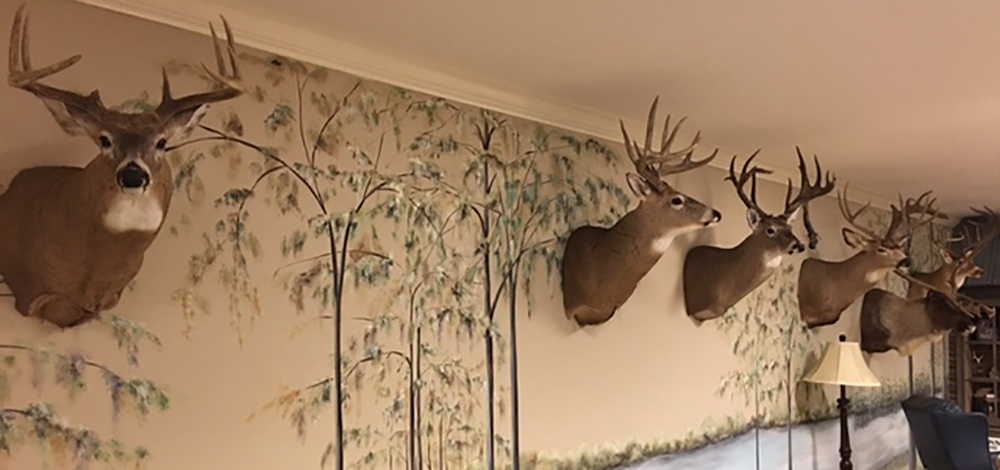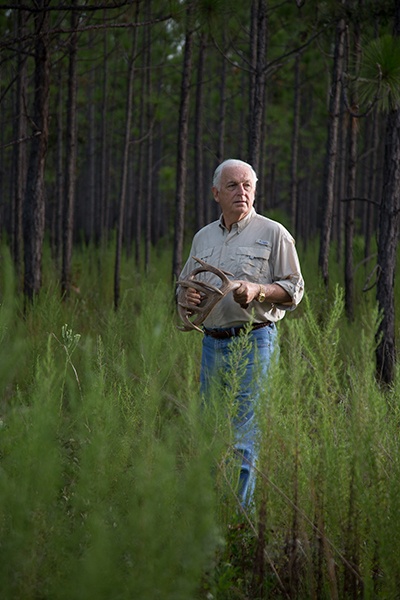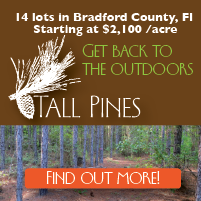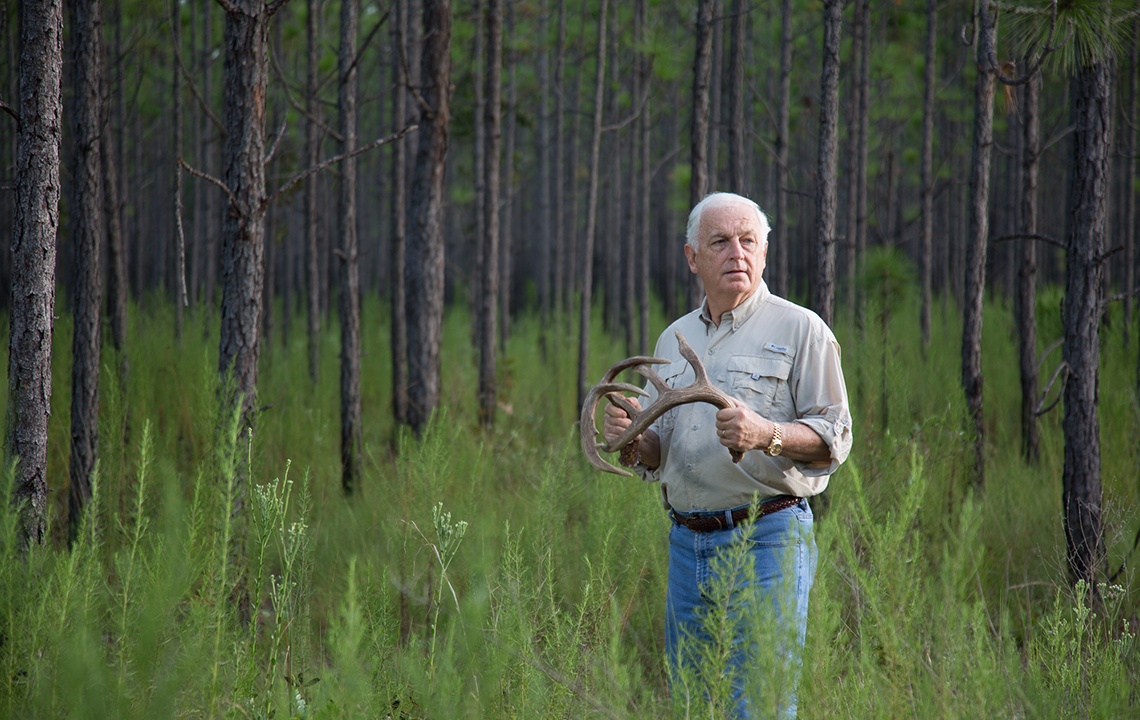Lifelong hunter and real estate company owner Steve Simmons shares his expert advice for creating a hunt club that will flourish for years to come.
This is the first article in a three-part series. See also:
Deep in the woods in total darkness, Steve Simmons waits for day to begin.
 As the first hint of light brings his surroundings into focus, he watches the shadows, waiting to see if they are bushes, logs, or maybe even animals. Finally, first light blankets the beautiful pines and oaks around him. Birds begin their morning songs, squirrels chatter as they chase each other from branch to branch, and a majestic buck meanders through the forest, leaves and twigs crackling under his hooves as he seeks out a breakfast of freshly-fallen acorns and honeysuckle.
As the first hint of light brings his surroundings into focus, he watches the shadows, waiting to see if they are bushes, logs, or maybe even animals. Finally, first light blankets the beautiful pines and oaks around him. Birds begin their morning songs, squirrels chatter as they chase each other from branch to branch, and a majestic buck meanders through the forest, leaves and twigs crackling under his hooves as he seeks out a breakfast of freshly-fallen acorns and honeysuckle.
His beautiful 8-point rack would tempt many hunters, but Steve puts down his bow and goes for his camera instead. Already the proud owner of a trophy room full of impressive mounts, he’s here just as much for the awesomeness of nature as he is for any game he may be hunting.
“It’s a shame that so few people have ever been in a deep woods setting to experience the woods waking up or going to sleep,” Simmons will later observe. “It’s so rewarding to simply observe the wildlife and see nature at its best.”
The making of a hunting land expert
After more than a half century of bow hunting, Simmons has learned the art of patience.
Whether hunting in the South; the frigid, untouched wilds of Alaska; or anywhere in between, he has been known to pass on many prized bucks and other big game. Unless they are more impressive than the ones on his wall, he’d rather let them go. He accepts the fact that they may never meet again, but if they do, the animals are more likely to have matured enough for Simmons to take a closer look.
Letting so many bucks walk is just the beginning of Simmons’ efforts to manage the wildlife on the land he hunts, helping to make it the best it can be for him and others to follow.
Because in addition to his love for nature and hunting, he is a man who loves great real estate. The owner of ERA Fernandina Beach Realty in Fernandina Beach, Florida, for 43 years, Simmons has played a major role in countless individual home and property sales as well as some of the biggest real estate deals on Amelia Island, including the island’s first and second Kmart, Publix shopping center, oceanfront condominiums and spec homes to many of the area’s prominent subdivisions.
His real estate career started when he and his brother, Ralph Simmons, got involved with the Sea Pines Company on Hilton Head Island in South Carolina. In the early ‘70s, they moved to Amelia Island to help pioneer the Amelia Island Plantation development for the Sea Pines Company.
But before he began his real estate career, Simmons went to school to study forestry, reinforcing his deep appreciation for forest land that continues to this day.
With this unique combination of expertise in nature, hunting and real estate, Simmons has a superior perspective in understanding how to evaluate - and create - the best hunting land in Florida and Georgia.
 Simmons' trophy room boasts a wall full of prize bucks. See more pictures of his trophy room in the second article in this series, "Why manage wildlife on hunting land?" / Photo courtesy of Steve Simmons
Simmons' trophy room boasts a wall full of prize bucks. See more pictures of his trophy room in the second article in this series, "Why manage wildlife on hunting land?" / Photo courtesy of Steve Simmons
3 major factors that influence the quality of hunting land
Sitting in his office just steps from the ocean recently, Simmons reflected on what qualities are required for ideal hunting land in Florida, Georgia and the rest of the United States. He said that there are three major factors – genetics, nutrition and age -- that influence the quality of game on most tracts of land. While genetics depends on the region, the other factors can be controlled by the quality of the land, itself, and the way that land is managed.
Simmons should know. He once created an exclusive hunting club under a hunting agreement with Rethink:Rural’s parent company, Rayonier Inc. The timber company, which owns more than 2 million acres of land primarily in the Southern United States, licenses much of its timberland for hunting, in addition to selling hunting land on tracts it no longer needs for its timber operations.
Simmons’ club was on a pristine tract north of Jacksonville off Lem Turner Road. As the owner of the exclusive hunting rights and manager of the club, Simmons wrote out a detailed plan to ensure the land gave hunters the best possible hunting and outdoor experience. He:
- mapped and named the more than two dozen dirt roads throughout the property;
- set rules to manage the wildlife, such as establishing a minimum antler size for deer to be harvested;
- worked with local rescue personnel to establish pre-arranged emergency landing spots for helicopters, should the need ever arise; and
- implemented supplemental feeding programs that not only attracted wildlife but also assisted in growth quality and sustainability.
The result was a property that continued to improve year after year -- and Simmons never had to search for members. He said he would still be managing and hunting there if the land had not sold to the State of Florida.
Exclusive hunting rights vs. buying hunting land
 Simmons said obtaining exclusive hunting rights is a great opportunity and option for hunters who don’t have the resources to purchase land outright. But he prefers ownership so he knows he'll have that land for many years to come, perhaps even for generations to come.
Simmons said obtaining exclusive hunting rights is a great opportunity and option for hunters who don’t have the resources to purchase land outright. But he prefers ownership so he knows he'll have that land for many years to come, perhaps even for generations to come.
“Even something small, like 50 to 100 acres, can provide a lot of enjoyment to someone who is looking for a hunting tract,” Simmons said.
In addition to the Rayonier tract he licensed, Simmons purchased land for a bow hunting club in Pulaski County, Georgia, in the 1980s. This club was especially tailored to Simmons’ preferences: he created deed restrictions against guns, allowing for an archery-only club, and the rule book was written before any members were brought in. Again, Simmons set limits to what the hunters could harvest, allowing the deer to mature in order to truly become trophy animals. The result of the carefully-managed property was undeniably successful. The first Pope and Young whitetail bucks to make the state record book in and around Pulaski County were taken there.
Deer hunting with a bow rather than a gun
To Simmons, who’s been bow hunting since 1965, archery is a much more challenging and rewarding experience than hunting with a gun. While he has plenty of gun-hunting friends and contends archery isn’t for everyone, he says he prefers it because:
- It’s more challenging to get a clear shot and make the right hit.
- Taking a shot is not as disturbing to the woods and wildlife (and sometimes, more importantly, nearby neighbors).
- It’s safer, especially for a hunter who likes to take family along -- and to Simmons, family and good friends should be an integral part of any hunt.
- You must become skillful to get close and disciplined in taking a shot.
- Bow hunting is more peaceful and relaxing.
- You’ll be able to see more game and understand their habits and movements so much more.
- To your benefit, the process will take more time and patience.
“The best way to become a good hunter is to bow hunt,” Simmons said. “You’ll learn so much that will help you become a better hunter, from the pre-season preparation to having more wildlife encounters when you can’t get a shot.”
Learning to hunt as a child
Simmons can’t remember a time in his life that he didn’t hunt and fish. He grew up on a South Georgia farm with a large lake, and his school bus driver knew to look for him first at the lake a half mile down the road from his house. Most mornings, he would get up early to fit in some fishing before heading to class. He and his family still own that farm, hunting, fishing and enjoying the outdoors whenever they go back. On part of the family’s land, Simmons has managed the Simmons Mill Pond Duck Hunting Preserve and Fishing Club for almost 25 years.
 Other hunts take him much further from home: He and a close friend hunt in the wilds of Alaska every September. Without a guide, they are flown out to remote areas typically more than 100 miles from civilization to be dropped off on a mountain ridge or a river bed and left to fend for themselves for a week or more.
Other hunts take him much further from home: He and a close friend hunt in the wilds of Alaska every September. Without a guide, they are flown out to remote areas typically more than 100 miles from civilization to be dropped off on a mountain ridge or a river bed and left to fend for themselves for a week or more.
“There’s no camp or facilities, just raw nature at its best!” Simmons says.
With other friends in October, he hunts bears and record-book whitetail bucks in Canada.
Regardless of how far he goes from home to chase the excitement that comes with bow hunting, he says, “Nothing is more enjoyable than gathering my arrows and hunting with lifelong friends in the beautiful woods of North Florida and South Georgia.”
All photography except trophy room by Gary Clark, a former Southern Living Magazine travel photographer and photographer of the United States Postal Service 2014 Star-Spangled Banner Forever stamp. See more of Gary's work and contact him at www.thegaryclark.com.
























